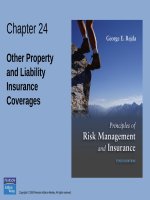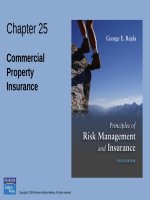Principles of risk management and insurance 12th by rejde mcnamara chapter 17
Bạn đang xem bản rút gọn của tài liệu. Xem và tải ngay bản đầy đủ của tài liệu tại đây (251.54 KB, 35 trang )
Chapter 17
Employee
Benefits:
Retirement Plans
Agenda
•
•
•
•
•
•
•
•
•
•
Fundamentals of Private Retirement Plans
Defined-Benefit Plans
Defined-Contribution Plans
Section 401(k) and 403(b) Plans
Profit-sharing Plans
Keogh Plans for the Self-Employed
Simplified Employee Pension
Simple Retirement Plans
Funding Agency and Funding Instruments
Problems and Issues in Tax-deferred Retirement
Plans
Copyright ©2014 Pearson Education, Inc. All rights reserved.
17-2
Fundamentals of Private Retirement
Plans
• Private retirement plans have an enormous
social and economic impact
– The Employee Retirement Income Security Act of
1974 (ERISA) established minimum standards
– The Pension Protection Act of 2006 increases the
funding obligation of employers
– Employers’ contributions are deductible, to certain
limits
– Investment earnings on the plan assets
accumulate on a tax-deferred basis
– Private plans that meet certain requirements are
called qualified plans and receive favorable
income tax treatment
Copyright ©2014 Pearson Education, Inc. All rights reserved.
17-3
Fundamentals of Private Retirement
Plans
• A qualified plan must benefit workers in
general and not only highly compensated
employees
• Certain minimum coverage requirements
must be satisfied
– Under the ratio-percentage test, the percentage
of non-highly compensated employees covered
under the plan must be at least 70% of the
percentage of highly compensated employees
who are covered
– Under the average benefits test, the average
benefit for non-highly compensated employees
must be at least 70% of the average benefit
provided to all highly compensated employees
Copyright ©2014 Pearson Education, Inc. All rights reserved.
17-4
Fundamentals of Private Retirement
Plans
• Most plans have a minimum age and service
requirement that must be met
– All eligible employees who have attained age 21
and have completed one year of service must be
allowed to participate in the plan
– Normal retirement age is the age that a worker
can retire and receive a full, unreduced pension
benefit (usually 65 years)
– An early retirement age is the earliest age that
workers can retire and receive a retirement
benefit
– The deferred retirement age is any age beyond
the normal retirement age
Copyright ©2014 Pearson Education, Inc. All rights reserved.
17-5
Fundamentals of Private Retirement
Plans
• Vesting refers to the employee’s right to the
employer’s contributions or benefits
attributable to the contributions if
employment terminates prior to retirement
• A qualified defined-benefit plan must meet
a minimum vesting standard
– Under cliff vesting, the worker must be 100%
vested after 5 years of service
– Under graded vesting, the worker must be 20%
vested by the 3rd year of service, and the
minimum vesting increases another 20% for
each year until the worker is 100% vested at
year 7
Copyright ©2014 Pearson Education, Inc. All rights reserved.
17-6
Fundamentals of Private Retirement
Plans
• Faster vesting is required for qualified
defined-contribution plans to encourage
greater employee participation
– Employer contributions must be 100% vested
after 3 years
– The worker must be 20% vested by the 2rd year
of service, and the minimum vesting increases
another 20% for each year until the worker is
100% vested at year 6
Copyright ©2014 Pearson Education, Inc. All rights reserved.
17-7
Fundamentals of Private Retirement
Plans
• Funds withdrawn from a qualified plan
before age 59½ are subject to a 10% early
distribution penalty
– There are some exceptions to this rule, for
example if the distribution is made because the
employee has a qualifying disability
• Pension contributions cannot remain in the
plan indefinitely
– Distributions must start no later than April 1st of
the calendar year following the year in which the
individual attains age 70½
– This rule does not apply to certain IRAs
Copyright ©2014 Pearson Education, Inc. All rights reserved.
17-8
Fundamentals of Private Retirement
Plans
• Many qualified private pension plans are
integrated with Social Security
– Integration provides a method for increasing
pension benefits for highly compensated
employees without increasing the cost of
providing benefits to lower-paid employees
– Employers must follow complex integration
rules, such as the excess method.
Copyright ©2014 Pearson Education, Inc. All rights reserved.
17-9
Fundamentals of Private Retirement
Plans
• A top-heavy plan is a retirement plan in
which more than 60% of the plan assets are
in accounts attributed to key employees
– To retain its qualified status, a special rapid
vesting schedule must be used for nonkey
employees
– Certain minimum benefits or contributions must
be provided for nonkey employees
Copyright ©2014 Pearson Education, Inc. All rights reserved.
17-10
Types of Qualified Retirement Plans
• A wide variety of qualified plans are
available today to meet the specific needs
of employers
• The two basic types of plans are
– Defined-benefit plans
– Defined-contribution plans
• Different rules apply to each type of plan
Copyright ©2014 Pearson Education, Inc. All rights reserved.
17-11
Defined-Benefit Plans
• In a defined-benefit plan, the retirement
benefit is known, but the contributions will
vary depending on the amount needed to
fund the desired benefit
– The amount can be based on career-average
earnings or on a final average pay, which
generally is an average of the last 3-5 years
earnings
– A firm may give an employee past-service
credits for prior service
Copyright ©2014 Pearson Education, Inc. All rights reserved.
17-12
Defined-Benefit Plans
• Contributions to defined benefit plans are
limited:
– For 2012, the maximum annual benefit is limited
to 100% of the worker’s average compensation
for the three highest consecutive years or
$200,000, whichever is lower
– The maximum annual compensation that can be
counted in the contribution of benefits formula
for all plans is $250,000
Copyright ©2014 Pearson Education, Inc. All rights reserved.
17-13
Defined-Benefit Plans
• Retirement benefits in defined-benefit plans
are based on formulas
– Under a unit-benefit formula, both earnings and
years of service are considered
– Some plans pay a flat percentage of annual
earnings, while some pay a flat amount for each
year of service
– Some plans pay a flat amount for each employee,
regardless of earnings or years of service
Copyright ©2014 Pearson Education, Inc. All rights reserved.
17-14
Defined-Benefit Plans
• The Pension Benefit Guaranty Corporation
(PBGC) is a federal corporation that
guarantees the payment of vested benefits
to certain limits if a private pension plan is
terminated
– For plans terminated in 2012, the maximum
guaranteed pension at age 65 is $4653.41 per
month
• Many traditional defined benefits plans are
substantially underfunded at the present
time
Copyright ©2014 Pearson Education, Inc. All rights reserved.
17-15
Defined-Benefit Plans
• A cash-balance plan is a defined-benefit plan
in which the benefits are defined in terms of a
hypothetical account balance
– Actual retirement benefits will depend on the value
of the participant’s account at retirement
– Each year, participant’s accounts are credited with
a pay credit and an interest credit
– The employer bears the investment risks and
realizes any investment gains
– Many employers have converted traditional
defined-benefit plans into cash-balance plans to
hold down pension costs
Copyright ©2014 Pearson Education, Inc. All rights reserved.
17-16
Defined-Contribution Plans
• In a defined-contribution plan, the
contribution rate is fixed but the actual
retirement benefit is variable
– For example, a money purchase plan is an
arrangement in which each participant has an
individual account, and the employer’s
contribution is a fixed percentage of the
participant’s compensation
Copyright ©2014 Pearson Education, Inc. All rights reserved.
17-17
Defined-Contribution Plans
• Contributions to defined-contribution
retirement plans are limited:
– For 2012, the maximum annual contribution to a
defined-contribution plan is 100% of earnings or
$50,000, whichever is lower
– Workers age 50 or older can make an additional
catch-up contribution of $5500 per year
Copyright ©2014 Pearson Education, Inc. All rights reserved.
17-18
Defined-Contribution Plans
• Most newly installed qualified retirement
plans are defined-contribution plans
– Cost to employer is lower because they do not
grant past-service credits
• Disadvantages to the employee include:
– Employees can only estimate their retirement
benefits
– Investment losses are borne by the employee
– Some employees do not understand the factors
to consider in choosing investments
Copyright ©2014 Pearson Education, Inc. All rights reserved.
17-19
Section 401(k) Plans
• A Section 401(k) plan is a qualified cash or
deferred arrangement (CODA) that allows
eligible employees the option of putting
money into the plan or receiving the funds as
cash
– Typically, both the employer and the employees
contribute, and the employer matches part or all
of the employee’s contributions
– Most plans allow employees to determine how the
funds are invested
– Employees can voluntarily elect to have part of
their salaries invested in the Section 401(k) plan
through an elective deferral
Copyright ©2014 Pearson Education, Inc. All rights reserved.
17-20
Section 401(k) Plans
• Contributions to a 401(k) plan accumulate
tax-free, and funds are taxed as ordinary
income when withdrawals are made
• For 2012, the maximum limit on elective
deferrals is $17,000 for workers under age
50
– A firm must satisfy an actual deferral percentage
test to prevent discrimination in favor of highly
compensated employees
Copyright ©2014 Pearson Education, Inc. All rights reserved.
17-21
Section 401(k) Plans
• If funds are withdrawn before age 59½, a
10% tax penalty applies, with some
exceptions
• The plan may permit the withdrawal of
funds for a hardship:
–
–
–
–
To pay certain unreimbursable medical expense
To purchase a primary residence
To pay post-secondary education expenses
To make payments to prevent eviction or
foreclosure on your home
– The 10% tax penalty applies, but plans typically
have a loan provision that allows funds to be
borrowed without a tax penalty
Copyright ©2014 Pearson Education, Inc. All rights reserved.
17-22
Section 401(k) Plans
• In a Roth 401(k) plan, you make
contributions with after-tax dollars, and
qualified distributions at retirement are
received income-tax free
– Investment earnings accumulate on a tax-free
basis
– Distributions from the plan are income-tax free is
you are at least 59½ and the account is held for
at least five years
Copyright ©2014 Pearson Education, Inc. All rights reserved.
17-23
Section 401(k) Plans
• An individual 401(k) retirement plan is a plan
that combines a profit-sharing plan with a
401(k) plan.
– It is limited to self-employed individuals with no
employees other than a spouse
– For 2012, the maximum annual contribution is
limited to 25 percent of compensation
– In addition, the business owner can elect a salary
deferral up to $17,000, which reduces taxable
income
– Workers over age 50 can make an additional
catch-up contribution of $5500
Copyright ©2014 Pearson Education, Inc. All rights reserved.
17-24
Section 403(b) plans
• A Section 403(b) plan is a retirement plan
designed for employees of public
educational systems and tax-exempt
organizations
– Eligible employees voluntarily invest a fixed
amount of their salaries in the plan
– Employers may make a matching contribution
– The plan can be funded by purchasing an
annuity or by investing in mutual funds
– The employer must purchase the annuity and it
is nontransferable
– Employee salary reductions are nonforteitable
Copyright ©2014 Pearson Education, Inc. All rights reserved.
17-25









